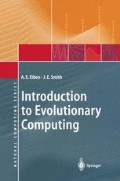Abstract
In this chapter we discuss special forms of evolution that in some sense deviate from the standard evolutionary algorithms. In particular, we present coevolution and interactive evolution that both work under “external influence”. In coevolution the influence comes from another population, whose members affect the fitness of the main population. In turn, the main population also influences the fitness of the other one; hence the two populations evolve together. In interactive evolution this influence comes from a user who defines the fitness values by subjective preferences. In both of these cases, the fitness that is awarded to a solution may vary. In the first case because the fitness is dependent on the evolutionary state of the second population, and in the second because users often display inconsistencies. We finish this chapter by describing evolutionary approaches to problems where changing evaluation criteria form the very feature defining them: nonstationary optimisation problems.
Access this chapter
Tax calculation will be finalised at checkout
Purchases are for personal use only
Preview
Unable to display preview. Download preview PDF.
References
P.J. Bentley, Ed. Evolutionary Design by Computers. Morgan Kaufmann, San Francisco, 1999
P.J. Bentley, D.W. Corne, Eds. Creative Evolutionary Systems. Academic Press, 2002
P.J. Bentley, D.W. Corne. An introduction to creative evolutionary systems. In Creative Evolutionary Systems (above), pp. 1–75
J. Branke, S. Kirby. Evolutionary Optimization in Dynamic Environments. Kluwer Academic Publishers, Boston, 2001
J. Branke, H. Schmeck. Designing evolutionary algorithms for dynamic optimization problems. In Ghosh, Tsutsui [167], pp. 239–262
W. D. Hillis. Coevolving parasites improve simulated evolution as an optimization procedure. In C. G. Langton et. al., Eds. Proceedings of the Workshop on Artificial Life (ALIFE ’90), pp. 313–324, Addison-Wesley, Redwood City, CA, USA, 1992
J. Paredis. Coevolutionary algorithms. In T. Bäck, D. Fogel, Z. Michalewicz, Eds. [26]
Author information
Authors and Affiliations
Rights and permissions
Copyright information
© 2003 Springer-Verlag Berlin Heidelberg
About this chapter
Cite this chapter
Eiben, A.E., Smith, J.E. (2003). Special Forms of Evolution. In: Introduction to Evolutionary Computing. Natural Computing Series. Springer, Berlin, Heidelberg. https://doi.org/10.1007/978-3-662-05094-1_13
Download citation
DOI: https://doi.org/10.1007/978-3-662-05094-1_13
Publisher Name: Springer, Berlin, Heidelberg
Print ISBN: 978-3-642-07285-7
Online ISBN: 978-3-662-05094-1
eBook Packages: Springer Book Archive

